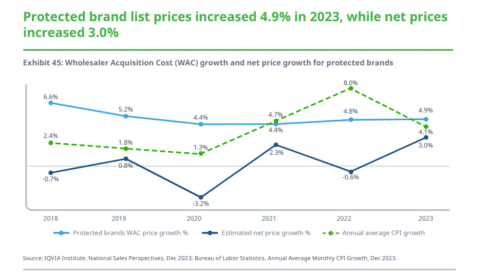A reminder: I’ll be carting my “Pitching Pricing” trading cards around #JPM24 today. If you want a pack, let me know your whereabouts.
It’s a short one today, because I’ll be logging some shoe-leather miles around San Francisco. It has, over the past decade, so often rained at this event that when the weather affords the ability to walk, I take it.
Plus, there’s not much to say right now. We have the annual delmaking announcements, but that’s really not my bag (nor are any particularly transformational). It’s worth noting that the three biggest takeouts this morning — J&J/Ambrx, Merck/Harpoon, and Novartis/Calypso — are all biologics plays.
I don’t think that means anything from the IRA-incentive POV, if we’re being honest (I’ll write more on that later). But, still …
So Bernie Sanders is going to go after the price of inhalers next, per the Washington Post.
There are a couple of ways to look at this. The surface level is to consider this one worth watching because the issues here are sufficiently complex — and the medicines widely enough available — that there’s likely to be plenty for a motivated politician to spotlight.
The politics here are probably good.
The other way to look at this is as an example of the inability of key stakeholders (that’s code for “policymakers” and, in some cases, “media”) to really get their arms around pricing. Because inhaler price is suddenly a really fascinating issue.
As we talked about last week, GSK did cut the price of Flovent, by taking Flovent off the market and replacing it with an identical authorized generic with a far lower list price.
And what happened when GSK did what Bernie Sander is agitating for?
PBMs restricted access.
That’s not the outcome that policymakers want. But nothing in the WaPo story even hinted at that piece of the puzzle.
So there will be an interesting test coming up. If the inhaler conversation is just about kicking the industry in the shins, that will be a signal that the drug-pricing conversation will remain insufficiently nuanced to actually solve any issues. If we have a broader conversation, though, maybe we’ll actually move forward.
The briefing is now complete in the AstraZeneca IRA suit — the government’s last brief hit on Friday — meaning that we’re now waiting on oral arguments (penciled in for the end of the month) and a decision (as early as March). This remains the most interesting and differentiated of the lawsuits, so the next 90 days will be well worth watching.
I don’t think that there is a lot of confusion about the origin of the bar on Medicare reimbursement of obesity meds (it was carved out so the government wouldn’t pay for “lifestyle drugs”), but this STAT op-ed lays out the evolution of the issue pretty well.
You all know I’m “meh” on the Florida importation stuff. But there were some great quotes on the topic over the weekend. Michigan law prof Nicolas Bagley — no reflexive defender of industry — quipped on Twitter “there is a yawning gap between the public enthusiasm for canadian drug imports and the consensus view from experts that it’s a daft approach.” And Peter Pitts had a nice turn of phrase in this NY Post op-ed, saying importation is “no longer a pipe dream. It’s now a pipe bomb.”
The effort by rare disease patients to raise concerns about the Maryland prescription drug affordability board is ramping up, as evidenced by this Maryland Matters opinion piece by a college student with a rare disease.
A couple of march-in rights op-eds to note. This one from the Dallas Morning News by a former member of Congress is fairly straightforward. This National Review piece is better, if only because it comes from a guy — former biotech exec Michael Astrue — who knows first-hand how disincentives work: “[W]hen I was Biogen’s general counsel, I watched my CEO kill a promising HIV program out of fear of exactly that kind of administrative bullying.”
If this email was forwarded to you, and you’d like to become a reader, click here to see back issues of Cost Curve and subscribe to the newsletter.





